Superblock Design and Evaluation by a Microscopic Door-to-Door Simulation Approach
Abstract
:1. Introduction
1.1. Introduction to Superblocks and Their Analysis
1.2. State of the Art
2. Materials and Methods
2.1. Microscopic Door-to-Door Simulation Approach
2.2. Superblock Configuration Identification
2.3. Bologna Study Area and Proposed Superblock Configuration
2.4. The Baseline Scenario and Its Validation
2.5. Implementing Bologna Superblocks Corresponding to Traffic Intervention Measures
3. Simulation Results
3.1. Evaluations of Modal Shifts at the Citywide and Superblock Levels
3.2. Evaluations of Door-to-Door Travel Time
3.3. Evaluations of Traffic Performance and Traffic-Related Air Emissions
4. Discussion
5. Conclusions
Author Contributions
Funding
Data Availability Statement
Conflicts of Interest
References
- IEA. Empowering Cities for a Net Zero Future: Unlocking Resilient, Smart, Sustainable Urban Energy Systems; OECD Publishing: Paris, France, 2021. [Google Scholar] [CrossRef]
- Ahn, D.Y.; Goldberg, D.L.; Coombes, T.; Kleiman, G.; Anenberg, S.C. CO2 emissions from C40 cities: Citywide emission inventories and comparisons with global gridded emission datasets. Environ. Res. Lett. 2023, 18, 034032. [Google Scholar] [CrossRef] [PubMed]
- Arioli, M.; Fulton, L.; Lah, O. Transportation strategies for a 1.5 °C world: A comparison of four countries. Transp. Res. Part D Transp. Environ. 2020, 87, 102526. [Google Scholar] [CrossRef]
- Mårtensson, H.B.; Larsen, K.; Höjer, M. Investigating potential effects of mobility and accessibility services using the avoid-shift-improve framework. Sustain. Cities Soc. 2023, 96, 104676. [Google Scholar] [CrossRef]
- Shah, K.J.; Pan, S.-Y.; Lee, I.; Kim, H.; You, Z.; Zheng, J.-M.; Chiang, P.-C. Green transportation for sustainability: Review of current barriers, strategies, and innovative technologies. J. Clean. Prod. 2021, 326, 129392. [Google Scholar] [CrossRef]
- Bongardt, D.; Stiller, L.; Stwar, A.; Wagner, A. Sustainable Urban Transport: Avoid-Shift-Improve (A-S-I); Deutsche Gesellschaft für Internationale Zusammenarbeit (GIZ) GmbH: Eschborn, Germany, 2019. [Google Scholar]
- Fransen, T.; Welle, B.; Gorcuinpour, C.; McCall, M.; Song, R.; Tankou, A. Enhancing NDCs: Opportunities in Transport; World Resources Institute: Washington, DC, USA, 2019. [Google Scholar]
- Fransen, T.; Henderson, C.; O’Connor, R.; Alayza, N.; Caldwell, M.; Chakrabarty, S.; Dixit, A.; Finch, M.; Kustar, A.; Langer, P.; et al. The State of Nationally Determined Contributions: 2022; World Resources Institute: Washington, DC, USA, 2022. [Google Scholar] [CrossRef]
- Mueller, N.; Rojas-Rueda, D.; Khreis, H.; Cirach, M.; Andrés, D.; Ballester, J.; Bartoll, X.; Daher, C.; Deluca, A.; Echave, C.; et al. Changing the urban design of cities for health: The superblock model. Environ. Int. 2020, 134, 105132. [Google Scholar] [CrossRef]
- López, I.; Ortega, J.; Pardo, M. Mobility infrastructures in cities and climate change: An analysis through the superblocks in Barcelona. Atmosphere 2020, 11, 410. [Google Scholar] [CrossRef]
- Rodriguez-Rey, D.; Guevara, M.; Linares, M.P.; Casanovas, J.; Armengol, J.M.; Benavides, J.; Soret, A.; Jorba, O.; Tena, C.; García-Pando, C.P. To what extent the traffic restriction policies applied in Barcelona city can improve its air quality? Sci. Total Environ. 2021, 807, 150743. [Google Scholar] [CrossRef] [PubMed]
- Vitale Brovarone, E.; Scudellari, J.; Staricco, L. Planning the transition to autonomous driving: A policy pathway towards urban liveability. Cities 2021, 108, 102996. [Google Scholar] [CrossRef]
- Benavides, J. Scaling the Superblock model to city level in Barcelona? Learning from recent policy impact evaluations. Contesti Città Territ. Progett. 2022, 2, 79–94. [Google Scholar]
- Bagloee, S.A.; Ceder, A.; Sarvi, M.; Asadi, M. Is it time to go for no-car zone policies? Braess Paradox Detection. Transp. Res. Part A Policy Pract. 2019, 121, 251–264. [Google Scholar] [CrossRef]
- Schweizer, J.; Poliziani, C.; Rupi, F.; Morgano, D.; Magi, M. Building a large-scale micro-simulation transport scenario using big data. ISPRS Int. J. Geo-Inf. 2021, 10, 165. [Google Scholar] [CrossRef]
- Bartin, B.; Ozbay, K.; Gao, J.; Kurkcu, A. Calibration and validation of large-scale traffic simulation networks: A case study. Procedia Comput. Sci. 2018, 130, 844–849. [Google Scholar] [CrossRef]
- Codeca, L.; Frank, R.; Faye, S.; Engel, T. Luxembourg SUMO Traffic (LuST) Scenario: Traffic Demand Evaluation. IEEE Intell. Transp. Syst. Mag. 2017, 9, 52–63. [Google Scholar] [CrossRef]
- Sánchez-Vaquerizo, J.A. Getting Real: The Challenge of Building and Validating a Large-Scale Digital Twin of Barcelona’s Traffic with Empirical Data. ISPRS Int. J. Geo-Inf. 2022, 11, 24. [Google Scholar] [CrossRef]
- Behrisch, M.; Bieker-Walz, L.; Erdmann, J.; Krajzewicz, D. SUMO—Simulation of Urban MObility: An Overview. In Proceedings of the SIMUL 2011, The Third International Conference on Advances in System Simulation, Barcelona, Spain, 23–28 October 2011. [Google Scholar]
- Rupi, F.; Bernardi, S.; Schweizer, J. Map-matching algorithm applied to bicycle global positioning system traces in Bologna. IET Intell. Transp. Syst. 2016, 10, 244–250. [Google Scholar] [CrossRef]
- Schweizer, J.; Rupi, F.; Filippi, F.; Poliziani, C. Generating activity based, multi-modal travel demand for SUMO. EPiC Ser. Eng. 2018, 2, 118–133. [Google Scholar] [CrossRef]
- Buchanan, C. Traffic in Towns: A Study of the Long Term Problems of Traffic in Urban Areas: Reports of the Steering Group and Working Group Appointed by the Minister of Transport; Her Majesty’s Stationery Office: London, UK, 1963. [Google Scholar]
- Karndacharuk, A.A.; Wilson, D.J.; Dunn, R.C.M. Evaluating shared spaces: Methodological framework and performance index. Road Transp. Res. 2013, 22, 52–61. [Google Scholar]
- Morris, D.; Enoch, M.; Pitfield, D.; Ison, S. Car-free development through UK community travel plans. Proc. Inst. Civ. Eng. Urban Des. Plan. 2009, 162, 19–27. [Google Scholar] [CrossRef]
- Joseph, E. Ben Changing the residential street scene- adapting the shared street (Woonerf) concept to the suburban environment. J. Am. Plan. Assoc. 1995, 61, 504–515. [Google Scholar] [CrossRef]
- Nobis, C. The impact of car-free housing districts on mobility behaviour—Case study. Sustain. World 2003, 6, 701–710. [Google Scholar]
- Bauer, U.; Stein, T. ‘Kiezblocks’ for Berlin: Thinking Beyond Bollards. 2022. Available online: https://Difu.de/en/17155 (accessed on 20 November 2023).
- Ornetzeder, M.; Hertwich, E.G.; Hubacek, K.; Korytarova, K.; Haas, W. The environmental effect of car-free housing: A case in Vienna. Ecol. Econ. 2008, 65, 516–530. [Google Scholar] [CrossRef]
- Kukina, I.; Fedchenko, I. Rethinking Evolution of Spatial Structure of Russian Microdistrict in the Post-Soviet Space. In Proceedings of the the XXV ISUF International Conference, Krasnoyarsk, Russia, 5–9 July 2018; pp. 273–280. Available online: https://elib.sfu-kras.ru/handle/2311/111698 (accessed on 20 November 2023).
- Ge, X.; Han, D. Sustainability-oriented configurational analysis of the street network of China’s superblocks: Beyond Marshall’s model. Front. Archit. Res. 2020, 9, 858–871. [Google Scholar] [CrossRef]
- Scoppa, M.; Bawazir, K.; Alawadi, K. Straddling boundaries in superblock cities. Assessing local and global network connectivity using cases from Abu Dhabi, UAE. Transp. Res. Part A Policy Pract. 2019, 130, 770–782. [Google Scholar] [CrossRef]
- Caballero, H.; Hidalgo, L.; Quijada-Alarcon, J. Study of Pedestrian Zone According to Superblock Criteria in the Casco Antiguo of Panama. Sustainability 2022, 14, 3459. [Google Scholar] [CrossRef]
- Li, K.; Wilson, J.P. Modeling the Health Benefits of Superblocks across the City of Los Angeles. Appl. Sci. 2023, 13, 2095. [Google Scholar] [CrossRef]
- Barcelona City Council. Urban Mobility Plan of Barcelona PMU 2013–2018; Barcelona City Council: Barcelona, Spain, 2014; Available online: https://ajuntament.barcelona.cat/ecologiaurbana/en/what-we-do-and-why/active-and-sustainable-mobility/urban-mobility-plan (accessed on 20 November 2023).
- Palència, L.; León-Gómez, B.B.; Bartoll, X.; Carrere, J.; Díez, E.; Font-Ribera, L.; Gómez, A.; López, M.J.; Marí-Dell’olmo, M.; Mehdipanah, R.; et al. Study protocol for the evaluation of the health effects of superblocks in barcelona: The “salut als carrers” (health in the streets) project. Int. J. Environ. Res. Public Health 2020, 17, 2956. [Google Scholar] [CrossRef]
- Roberts, D. Superblocks. Barcelona’s Plan to Free Itself from Cars. 2019. Available online: https://kleinmanenergy.upenn.edu/research/publications/superblocks-barcelonas-plan-to-free-itself-from-cars/ (accessed on 20 November 2023).
- Eggimann, S. Expanding urban green space with superblocks. Land Use Policy 2022, 117, 106111. [Google Scholar] [CrossRef]
- Eggimann, S. The potential of implementing superblocks for multifunctional street use in cities. Nat. Sustain. 2022, 5, 406–414. [Google Scholar] [CrossRef]
- Rueda, S. Superblocks for the design of new cities and renovation of existing ones: Barcelona’s case. In Integrating Human Health into Urban and Transport Planning: A Framework; Springer: Cham, Switzerland, 2018; pp. 135–153. [Google Scholar] [CrossRef]
- Sarwar, S.; Saurí, S.; Bilal, M.T.; Majoral, G. Analysis of superblocks during the transition phase from traditional vehicles to fully automated vehicle environment: A case study of Barcelona City. Transp. Eng. 2023, 13, 100203. [Google Scholar] [CrossRef]
- Bernardi, S.; Krizek, K.J.; Rupi, F. Quantifying the role of disturbances and speeds on separated bicycle facilities. J. Transp. Land Use 2016, 9, 105–119. [Google Scholar] [CrossRef]
- Caliper. TransCAD Transportation Planning Software. Available online: www.caliper.com/tcovu.htm (accessed on 20 November 2023).
- Ajuntament de Barcelona; Agència d’Ecologia Urbana de Barcelona. Pla de Mobilitat Urbana de Barcelona 2013–2018: Introducció, Diagnosi i Escenaris; Barcelona City Council: Barcelona, Spain, 2015; Available online: https://ajuntament.barcelona.cat/ecologiaurbana/sites/default/files/PMU-BCN-2013-2018_Introduccio_i_diagnosi.pdf (accessed on 20 November 2023).
- Montero, L.; Linares, P.; Salmerón, J.; Recio, G.; Lorente, E.; Vázquez, J.J. Barcelona Virtual Mobility Lab: The multimodal transport simulation testbed for emerging mobility concepts evaluation. In Proceedings of the Tenth International Conference on Adaptive and Self-Adaptive Systems and Applications, ADAPTIVE 2018, Barcelona, Spain, 18–22 February 2018; IARIA: Wilmington, DE, USA, 2018; pp. 107–110. Available online: http://hdl.handle.net/2117/123910 (accessed on 20 November 2023).
- PTV Group. PTV Visum—Multimodal Transport Planning. 2018. Available online: https://www.ptvgroup.com/en/products/ptv-visum/knowledge-base (accessed on 20 November 2023).
- Brenner, A.; Haas, W.; Vienna, L.S.; Rudloff, C.; Haberl, H.; Vienna, L.S. How Experiments with Superblocks in Vienna Shape Climate and Health Outcomes and Interact with the Urban Planning Regime. SSRN 2023. [Google Scholar] [CrossRef]
- Greene, W.; Hensher, D. A Latent Class Model for Discrete Choice Analysis: Contrasts with Mixed Logit. Transp. Res. Part B Methodol. 2003, 37, 681–698. [Google Scholar] [CrossRef]
- Hössinger, R.; Aschauer, F.; Jara-Díaz, S.; Jokubauskaite, S.; Schmid, B.; Peer, S.; Axhausen, K.W.; Gerike, R. A joint time-assignment and expenditure-allocation model: Value of leisure and value of time assigned to travel for specific population segments. Transportation 2020, 47, 1439–1475. [Google Scholar] [CrossRef]
- Müller, J.; Straub, M.; Stubenschrott, M.; Graser, A. Simulation of a full-scale implementation of Superblocks in Vienna. In Proceedings of the 15th ITS European Congress, Lisbon, Portugal, 22–24 May 2023. [Google Scholar]
- Delhoum, Y.; Belaroussi, R.; Dupin, F.; Zargayouna, M. Activity-based demand modeling for a future urban district. Sustainability 2020, 12, 5821. [Google Scholar] [CrossRef]
- Moeckel, R.; Kuehnel, N.; Llorca, C.; Moreno, A.T.; Rayaprolu, H. Agent-Based Simulation to Improve Policy Sensitivity of Trip-Based Models. J. Adv. Transp. 2020, 2020, 1902162. [Google Scholar] [CrossRef]
- Rodriguez-Rey, D.; Guevara, M.; Linares, M.P.; Casanovas, J.; Salmerón, J.; Soret, A.; Jorba, O.; Tena, C.; Pérez García-Pando, C. A coupled macroscopic traffic and pollutant emission modelling system for Barcelona. Transp. Res. Part D Transp. Environ. 2021, 92, 102725. [Google Scholar] [CrossRef]
- Open Street Map (OSM). Available online: www.openstreetmap.org (accessed on 20 November 2023).
- Benenson, I.; Martens, K.; Rofé, Y.; Kwartler, A. Public transport versus private car GIS-based estimation of accessibility applied to the Tel Aviv metropolitan area. Ann. Reg. Sci. 2011, 47, 499–515. [Google Scholar] [CrossRef]
- Cascetta, E. Transportation Systems Engineering: Theory and Methods; Springer: Dordrecht, The Netherlands, 2001. [Google Scholar]
- Eclipse. Dynamic User Assignment. 2023. Available online: https://sumo.dlr.de/docs/Demand/Dynamic_User_Assignment.html (accessed on 20 November 2023).
- Osservatorio PUMS. Available online: www.osservatoriopums.it/bologna (accessed on 20 November 2023).
- Giovanardi, M.; Silvagni, M.G. Profiling ‘Red Bologna’: Between neoliberalisation tendencies and municipal socialist legacy. Cities 2021, 110, 103059. [Google Scholar] [CrossRef]
- Comune di Bologna. Open Data. 2022. Available online: https://opendata.comune.bologna.it/explore/?sort=modified (accessed on 20 November 2023).
- Città Metropolitana di Bologna. SUMP: Sustainable Urban Mobility Plan of Metropolitan Bologna; Città Metropolitana di Bologna: Bologna, Italy, 2014; Available online: https://pumsbologna.it/Sfoglia_la_sintesi/SUMP_Sustainable_Urban_Mobility_Plan_of_metropolitan_Bologna (accessed on 20 November 2023).
- Tper. Bologna Bus Service GTFS. 2023. Available online: https://solweb.tper.it/web/tools/open-data/open-data-detail.aspx?source=&filename=gtfsmex&version=20230110 (accessed on 20 November 2023).
- Eclipse. SUMO Netedit. 2023. Available online: https://sumo.dlr.de/docs/Netedit/index.html (accessed on 20 November 2023).
- Censimento Popolazione e Abitazioni. 2001. Available online: https://www.istat.it/it/archivio/3847 (accessed on 20 November 2023).
- Wardman, M.; Chintakayala, V.P.K.; de Jong, G. Values of travel time in Europe: Review and meta-analysis. Transp. Res. Part A Policy Pract. 2016, 94, 93–111. [Google Scholar] [CrossRef]
- Fezzi, C.; Bateman, I.J.; Ferrini, S. Using revealed preferences to estimate the value of travel time to recreation sites. J. Environ. Econ. Manag. 2014, 67, 58–70. [Google Scholar] [CrossRef]
- Comune di Bologna. Rilevazione Flusso Veicoli Tramite Spire—Anno 2022; Comune di Bologna: Bologna, Italy, 2022; Available online: https://opendata.comune.bologna.it/explore/dataset/rilevazione-flusso-veicoli-tramite-spire-anno-2022/information/?disjunctive.codice_spira&disjunctive.tipologia&disjunctive.nome_via&disjunctive.stato&sort=-data (accessed on 20 November 2023).
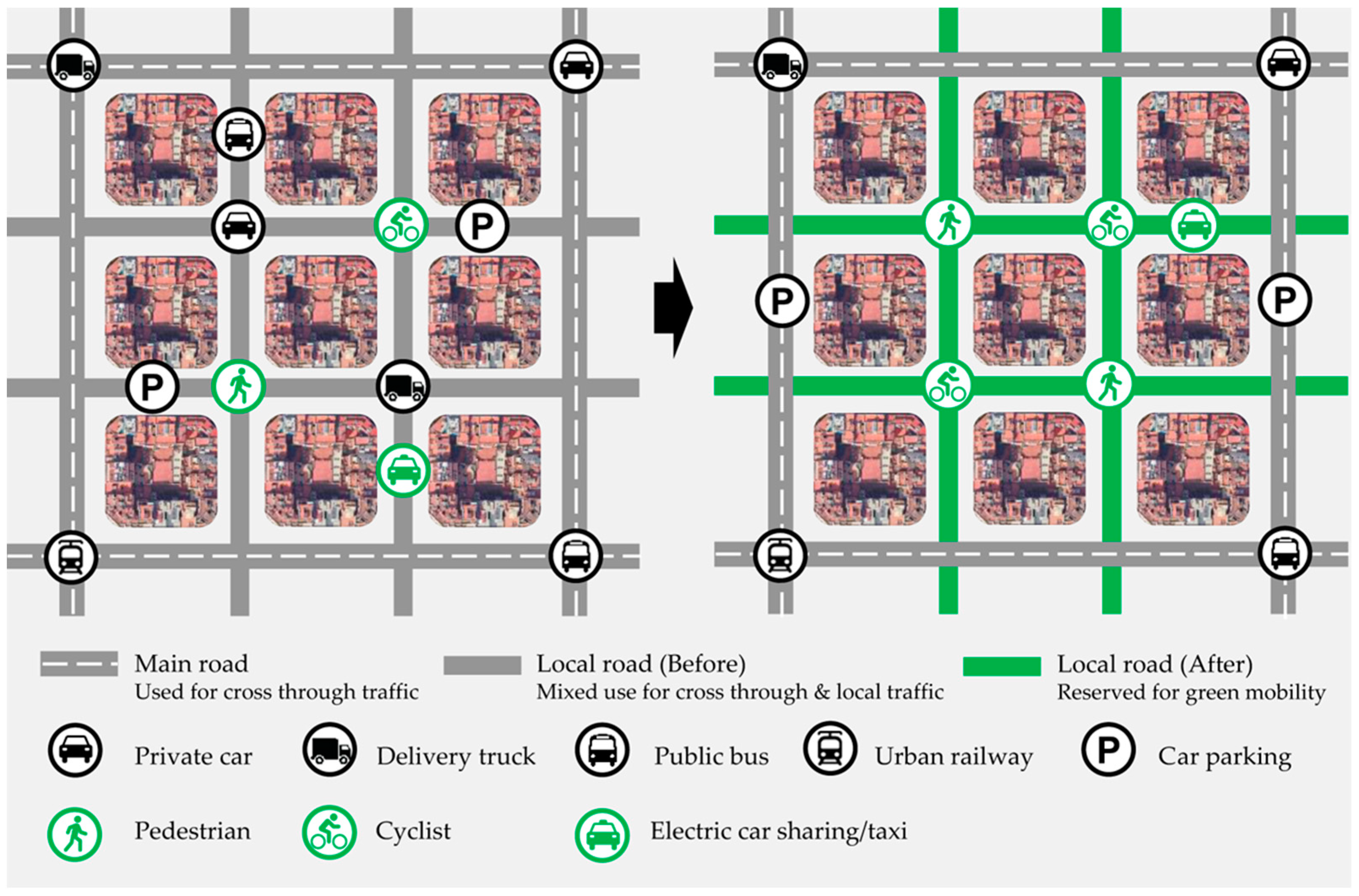
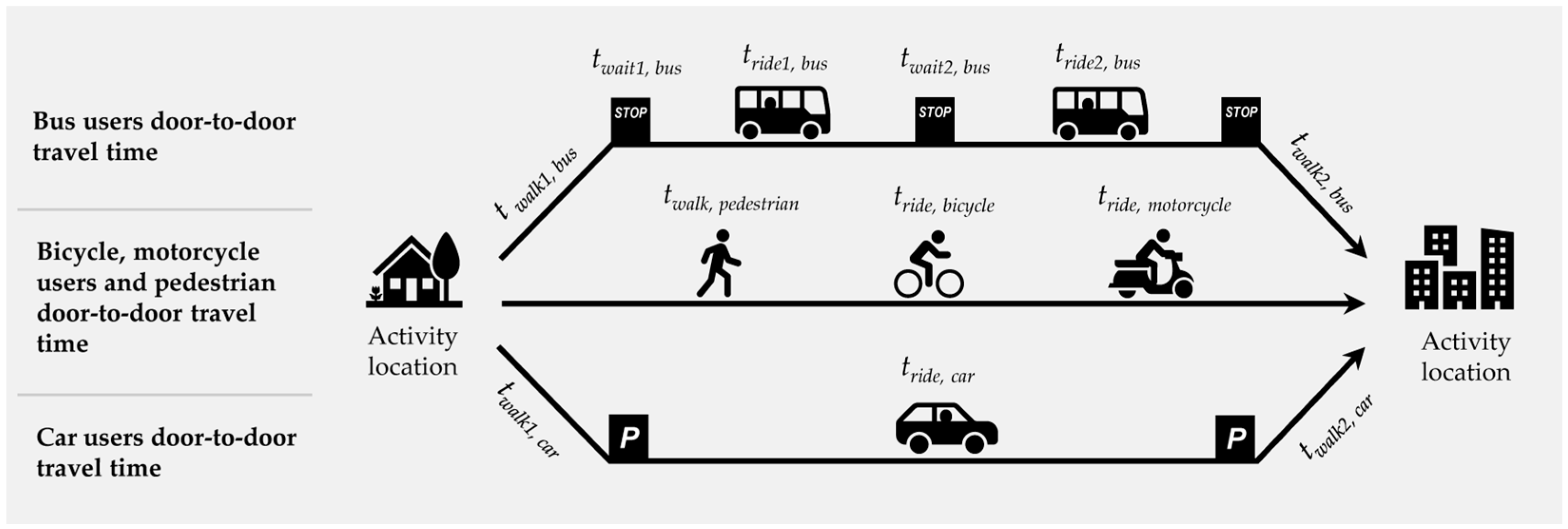


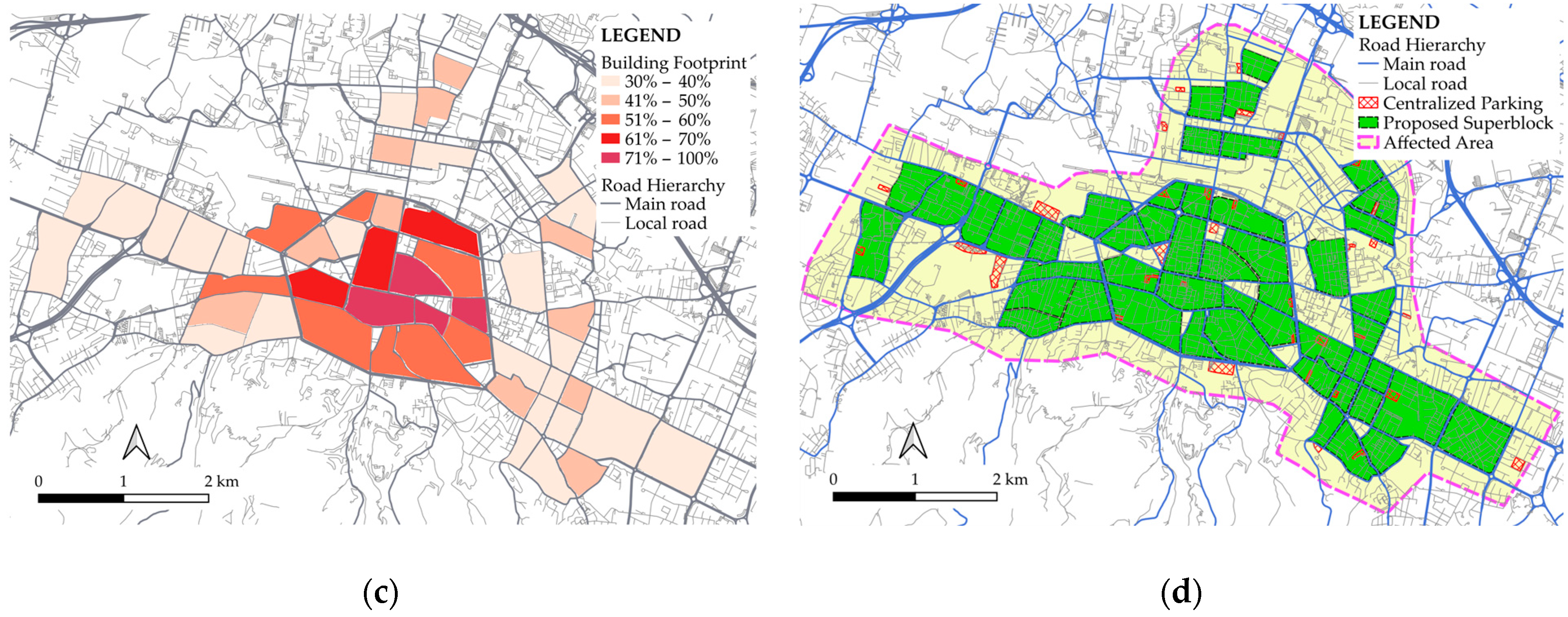
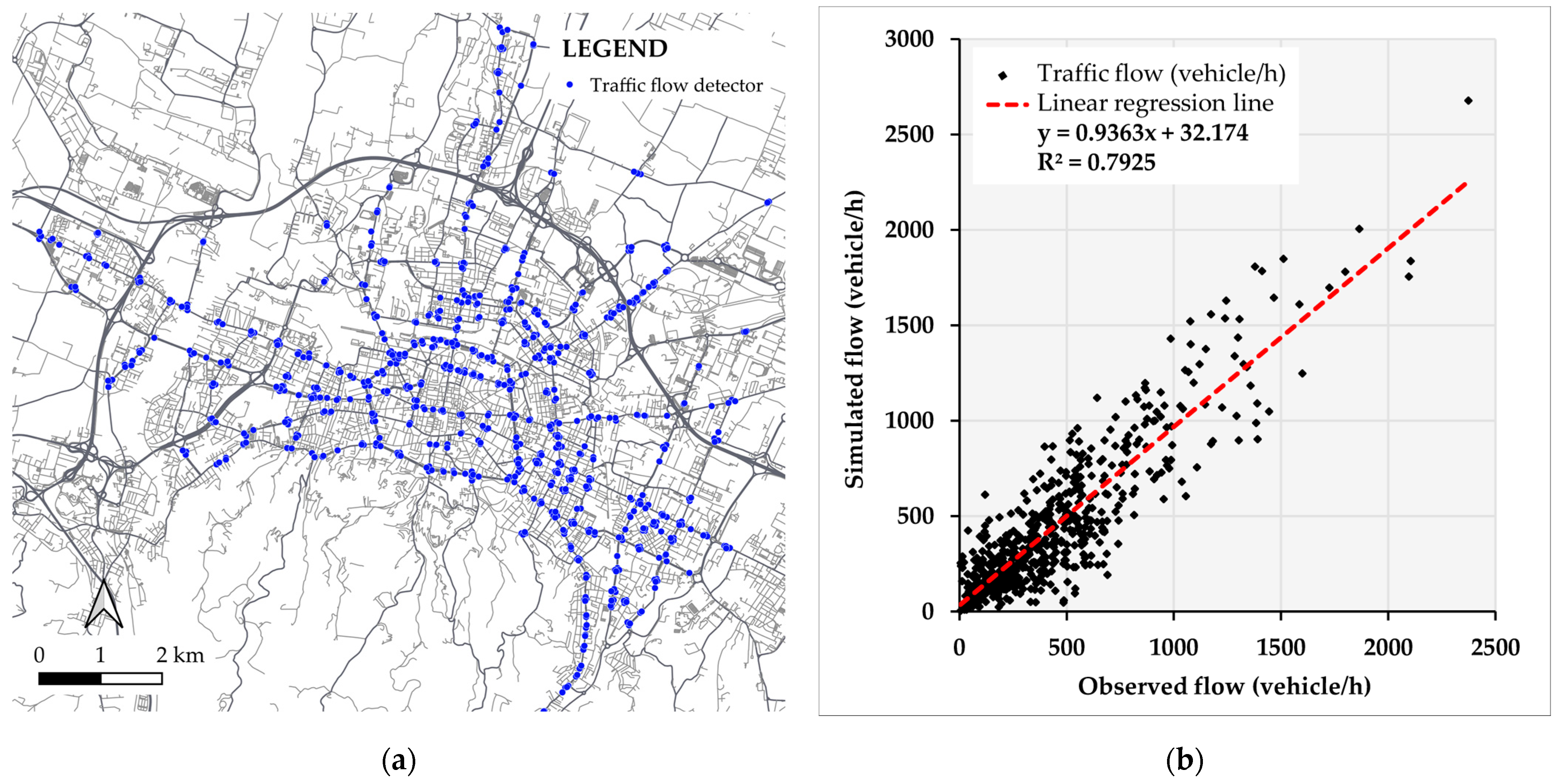
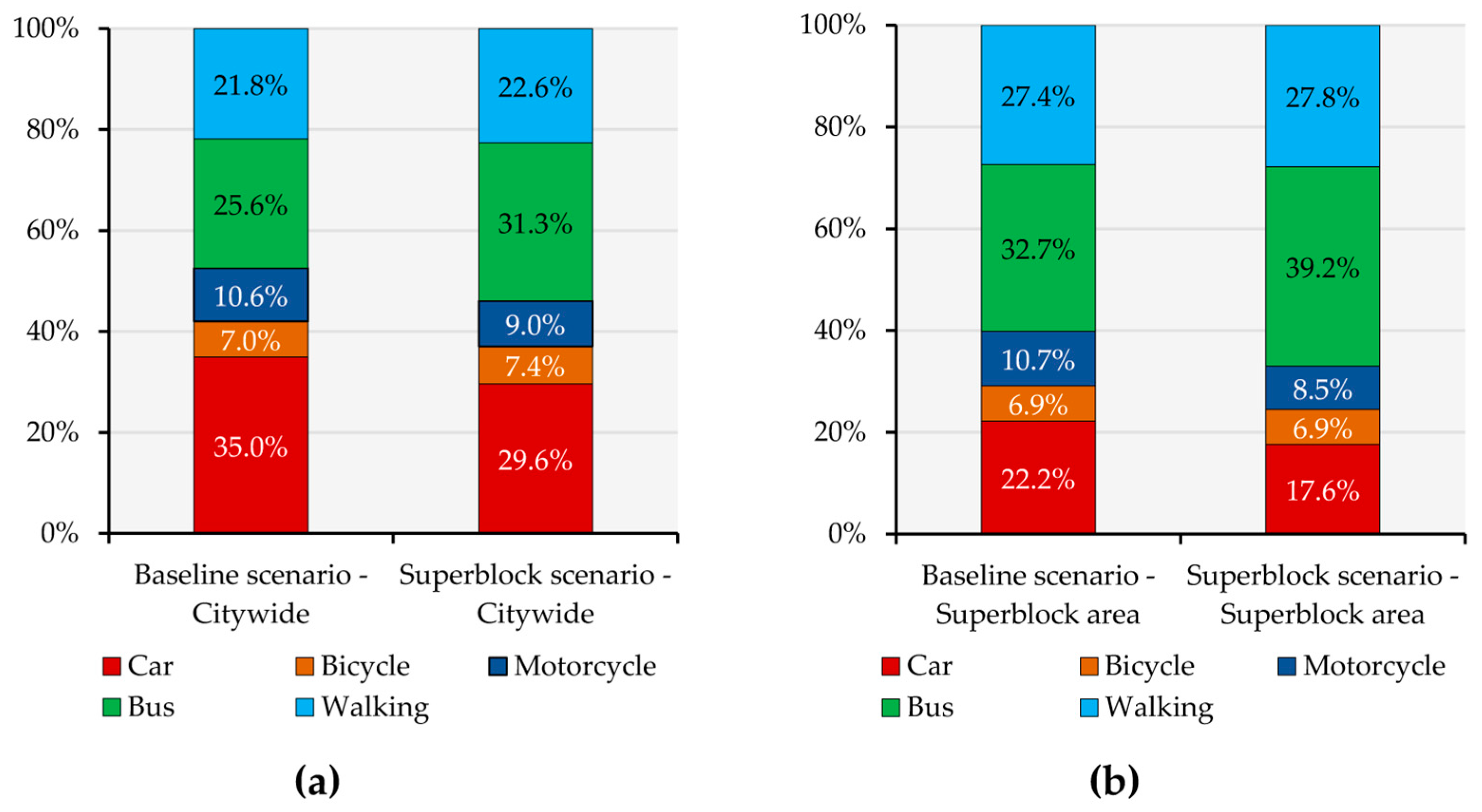
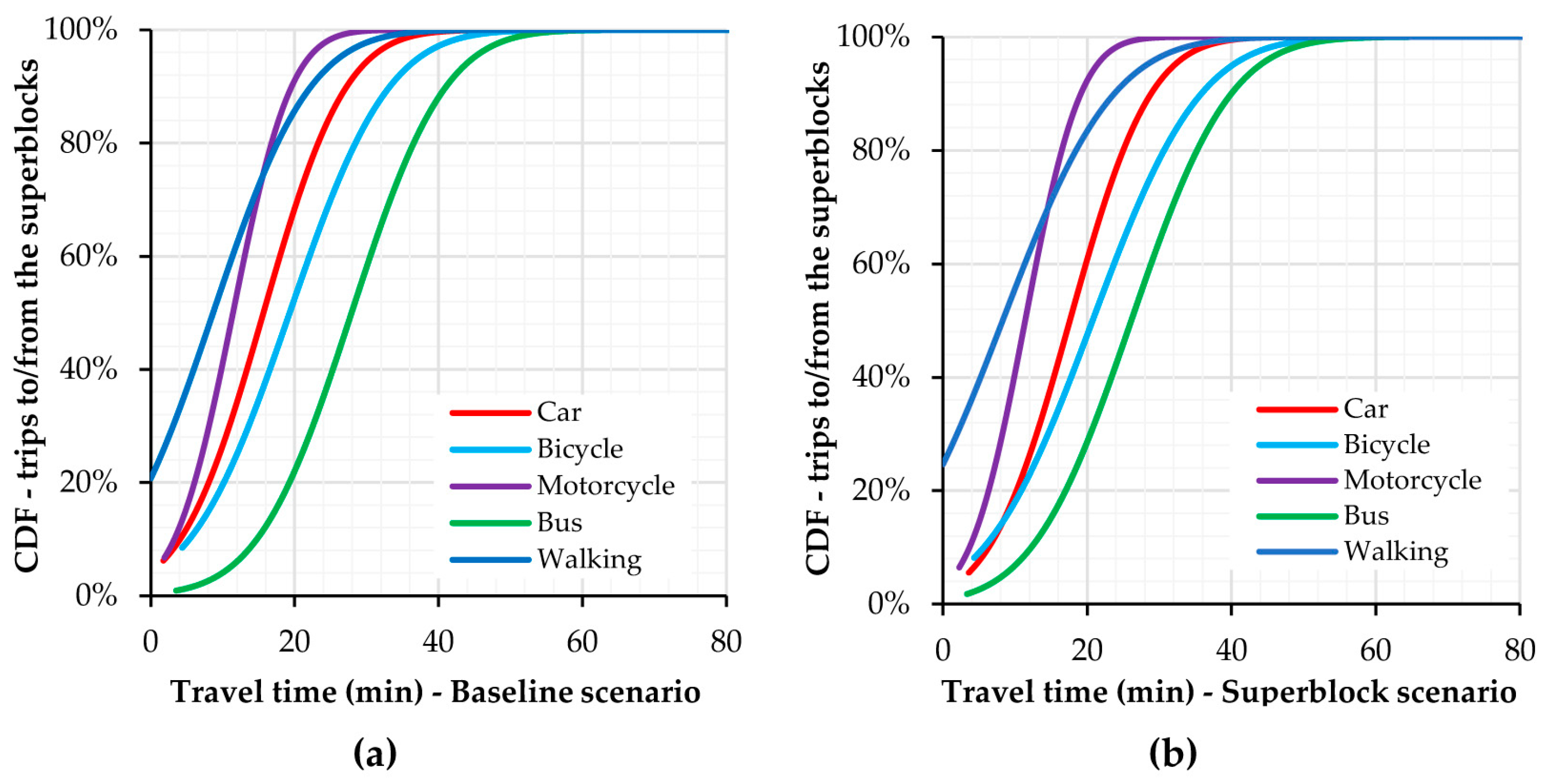

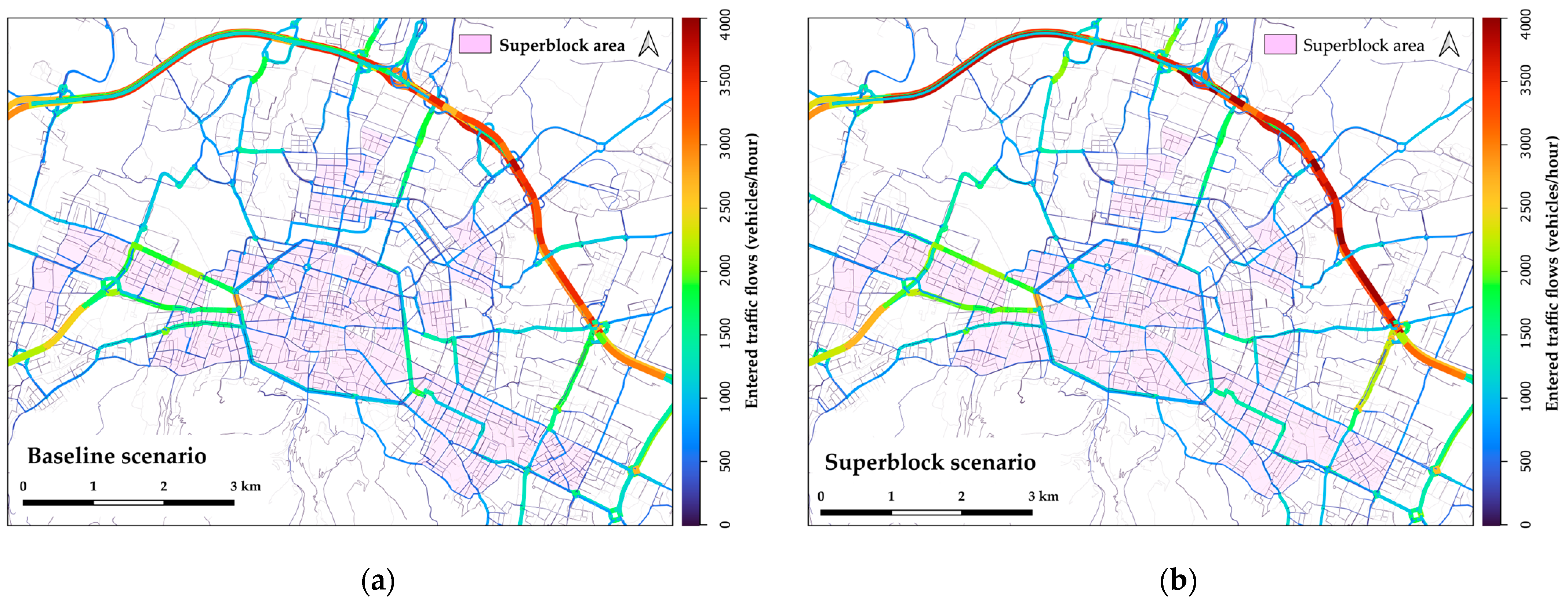
| # | Case Study | Superblock Scale | Traffic Model | Superblock Mode-Share Assumptions or Model | Traffic Simulator | Reference |
|---|---|---|---|---|---|---|
| 1 | Barcelona, Spain | 503 superblocks | Four-step model, O-D matrix | “Desired” mobility model | TRANSCAD, macroscopic model | [43] |
| 2 | Barcelona, Spain | 503 superblocks | Not applicable | Hypothesized modal shift | Not applicable | [9] |
| 3 | Barcelona, Spain | 6 superblocks | Four-step model, 2017 O-D matrix from mobile phone | Assumed reduction of 0% and 25% circulating vehicles | VISUM, macroscopic model | [11] |
| 4 | Vienna, Austria | 3 superblocks | Latent class model | Assumed reduction in kilometers traveled by car and shift to active modes | Not applicable | [46] |
| 5 | Vienna, Austria | 46 superblocks | Agent-based model, 12.5% population | Based on a linear polynomial model to fit curves for each mode | MATSim, mesoscopic model | [49] |
| 6 | Bologna, Italy | 49 superblocks | Activity base, disaggregation of O-D matrix, GTFS, 100% population | Mode-share model based on utility function including individual door-to-door trip time | SUMOPy/SUMO, large-scale microscopic model | This paper |
| α1 Car (ref.) | α2 Bike in EUR | α3 Bus in EUR | α4 Walking in EUR | α5 Scooter in EUR | β in EUR/s |
|---|---|---|---|---|---|
| 0 | −0.2604 | 1.855 | 2.016 | −0.0761 | 0.002 |
| # | Targeted Areas | Area (km2) | Population | Number of Edges | Mobility Evaluation Indicators | |||
|---|---|---|---|---|---|---|---|---|
| Modal Share | Door-to-Door Travel Time | Traffic Performance | Traffic-Related Air Emissions | |||||
| 1 | Citywide | 50.0 | 167,062 | 32,409 | ☑ | ☐ | ☐ | ☐ |
| 2 | Affected area | 23.8 | 121,509 | 9480 | ☑ | ☐ | ☑ | ☑ |
| - | Within superblock | 10.7 | 69,950 | 4711 | ☐ | ☑ | ☑ | ☑ |
| - | Adjacent area | 13.1 | 51,559 | 4769 | ☐ | ☐ | ☑ | ☑ |
| # | Door-to-Door Travel Time per Trip to/from the Superblocks by Modes | Number of Trips | Mean (min/trip) | Median (min/trip) | Std. Deviation | T-Test | |
|---|---|---|---|---|---|---|---|
| 1 | All mode | Total travel time | 39,159 (39,676) | 16.43 (15.08) | 13.93 (12.03) | 13.73 (12.03) | *** |
| 2 | Car trip | Total travel time | 5785 (8637) | 20.59 (16.65) | 18.6 (14.43) | 9.67 (8.98) | *** |
| Walking time | 5.42 (2.95) | 3.85 (1.73) | 5.36 (4.18) | *** | |||
| Riding time | 14.31 (13.15) | 12.68 (11.28) | 7.55 (7.55) | n.s. | |||
| 3 | Bus trip | Total travel time | 10,253 (6548) | 29.98 (32.78) | 28.73 (30.85) | 11.95 (13.72) | *** |
| Walking time | 7.12 (6.85) | 5.86 (5.57) | 5.44 (5.10) | *** | |||
| Riding time | 16.27 (16.6) | 15.23 (15.60) | 8.49 (8.77) | ** | |||
| Waiting time | 6.86 (9.06) | 6.18 (7.82) | 4.84 (6.88) | * | |||
| 4 | Bicycle trip | Total travel time | 2257 (2545) | 24.03 (23.48) | 21.2 (20.65) | 11.78 (11.48) | *** |
| 5 | Motorcycle trip | Total travel time | 4102 (4943) | 11.98 (11.74) | 10.28 (10.18) | 6.7 (6.35) | n.s. |
| 6 | Walking | Total travel time | 16,739 (17,003) | 6.77 (7.18) | 2.83 (2.83) | 8.16 (8.86) | ** |
| # | Targeted Areas | Abs. Entered Flows (103 veh./h) | Changes in Entered Flows (%) | Av. Traffic Density (veh./km) | Changes in Traffic Density (%) | Av. Travel Speeds (km/h) | Changes in Travel Speed (%) |
|---|---|---|---|---|---|---|---|
| 1 | Affected Area | 1270 (1475) | −13.94% | 245 (267) | −8.09% | 22.17 (22.20) | −0.14% |
| 2 | Within superblock | 141 (273) | −48.48% | 46 (92) | −49.95% | 21.46 (21.48) | −0.09% |
| 3 | Adjacent roads | 1129 (1202) | −6.09% | 432 (435) | −0.78% | 22.79 (22.87) | −0.35% |
Disclaimer/Publisher’s Note: The statements, opinions and data contained in all publications are solely those of the individual author(s) and contributor(s) and not of MDPI and/or the editor(s). MDPI and/or the editor(s) disclaim responsibility for any injury to people or property resulting from any ideas, methods, instructions or products referred to in the content. |
© 2024 by the authors. Licensee MDPI, Basel, Switzerland. This article is an open access article distributed under the terms and conditions of the Creative Commons Attribution (CC BY) license (https://creativecommons.org/licenses/by/4.0/).
Share and Cite
Nguyen, N.A.; Schweizer, J.; Rupi, F.; Palese, S.; Posati, L. Superblock Design and Evaluation by a Microscopic Door-to-Door Simulation Approach. ISPRS Int. J. Geo-Inf. 2024, 13, 77. https://doi.org/10.3390/ijgi13030077
Nguyen NA, Schweizer J, Rupi F, Palese S, Posati L. Superblock Design and Evaluation by a Microscopic Door-to-Door Simulation Approach. ISPRS International Journal of Geo-Information. 2024; 13(3):77. https://doi.org/10.3390/ijgi13030077
Chicago/Turabian StyleNguyen, Ngoc An, Joerg Schweizer, Federico Rupi, Sofia Palese, and Leonardo Posati. 2024. "Superblock Design and Evaluation by a Microscopic Door-to-Door Simulation Approach" ISPRS International Journal of Geo-Information 13, no. 3: 77. https://doi.org/10.3390/ijgi13030077
APA StyleNguyen, N. A., Schweizer, J., Rupi, F., Palese, S., & Posati, L. (2024). Superblock Design and Evaluation by a Microscopic Door-to-Door Simulation Approach. ISPRS International Journal of Geo-Information, 13(3), 77. https://doi.org/10.3390/ijgi13030077










